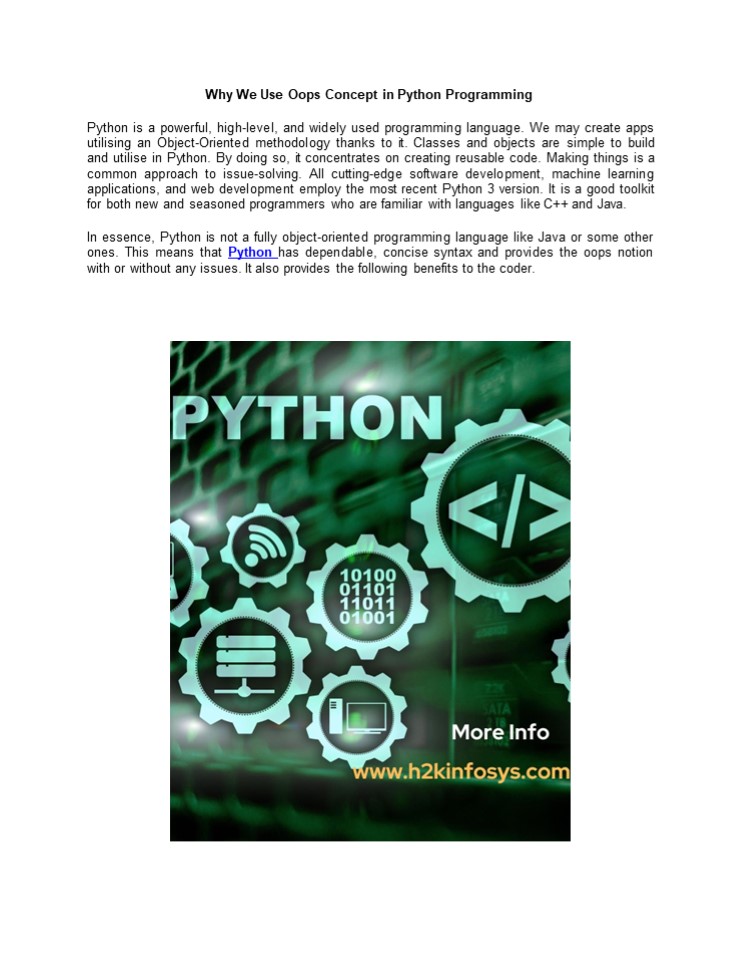Why We Use Oops Concept in Python Programming - PowerPoint PPT Presentation
Title:
Why We Use Oops Concept in Python Programming
Description:
Python is a powerful, high-level, and widely used programming language. We may create apps utilising an Object-Oriented methodology thanks to it. Classes and objects are simple to build and utilise in Python. By doing so, it concentrates on creating reusable code. For more Visit: – PowerPoint PPT presentation
Number of Views:9
Title: Why We Use Oops Concept in Python Programming
1
Why We Use Oops Concept in Python
Programming Python is a powerful, high-level,
and widely used programming language. We may
create apps utilising an Object-Oriented
methodology thanks to it. Classes and objects are
simple to build and utilise in Python. By doing
so, it concentrates on creating reusable code.
Making things is a common approach to
issue-solving. All cutting-edge software
development, machine learning applications, and
web development employ the most recent Python 3
version. It is a good toolkit for both new and
seasoned programmers who are familiar with
languages like C and Java. In essence, Python
is not a fully object-oriented programming
language like Java or some other ones. This
means that Python has dependable, concise syntax
and provides the oops notion with or without any
issues. It also provides the following benefits
to the coder.
2
- Easy to Learn Code
- Free and High-Level Language
- Portable
- Large Collection of Packages and Modules
- Why the object-oriented (oops) concept?
- Then why do we need Oops in Python when
everything is working properly? After all, as we
all know, oops (object-oriented programming)
also offers some advantages to programming
languages like - Modularity for simpler problem-solving
- Reusing code by inheriting it
- Adaptability via polymorphism
- Successful problem-solving, etc.
- These ideas elevate Python to a more distinctive,
well-known, and contemporary language. Let's
begin an in-depth study of how Python's Oops
pillars function. Check out the Python course
online to learn more about the Oops concept. - Oops Concept
- Python is a great programming language that
supports Object-Oriented Programming systems and
is called OOPS. - Class
- Objects
- Encapsulation
- Inheritance
3
- The variables that make up a class are known as
attributes. - With the dot (.) operator, attributes can always
be retrieved and are always public. For example
Myclass.Myattribute - Objects in Python
- The object is an entity that is connected to a
state and activity. Any physical device, such as
a mouse, keyboard, chair, table, pen, etc., may
be used. Arrays, dictionaries, strings, floating-
point numbers, and even integers are all
examples of objects. Any single string or
integer, more specifically, is an object. A list
is an object that may house other things, the
number 12 is an object, the text "Hello, world"
is an object, and so on. You may not even be
aware of the fact that you have been using
items. - An object includes
- State An object's properties serve as a
representation of it. Additionally, it reflects
an object's characteristics. - Behaviour The methods of an object serve as a
representation of behaviour. It also - shows how one object reacts to other objects.
- Identity It gives a thing a special name and
makes it possible for one object to communicate
with another.
4
- Let's use the example of the class dog (described
above) to better grasp the state, behaviour, and
identity. - The identity may be regarded as the dog's name.
- Breed, age, and colour of the dog are examples of
states or attributes. - You may infer from the behaviour whether the dog
is eating or sleeping. - Encapsulation
- It explains the concept of data wrapping and the
techniques that operate on data as a single
unit. This restricts direct access to variables
and procedures and can avoid data alteration by
accident. A variable can only be altered by an
object's method in order to prevent inadvertent
modification. These variables fall under the
category of private variables. - A class, which encapsulates all the data that is
contained in its member functions, variables,
etc., is an example of encapsulation. - Inheritance
- One class's ability to derive or inherit
properties from another class is known as
inheritance. - The advantages of inheritance include
- It accurately depicts relationships in the real
world. - It offers a code's reusability. We don't need to
keep writing the same code. It enables us to
expand a class's functionalities without changing
the class itself. - Because it is transitive, if class B inherits
from additional class A, all of class B's - subclasses will also automatically inherit from
class A.
5
Conclusion If you are a Python programmer, you
can learn more about the OOPS concept by checking
out the online Python course. Tags
onlinecertificatepython bestpythononlinetraining
Toptenonlinetrainingpython PythonCourseOnline
PythonCertificationCourse































